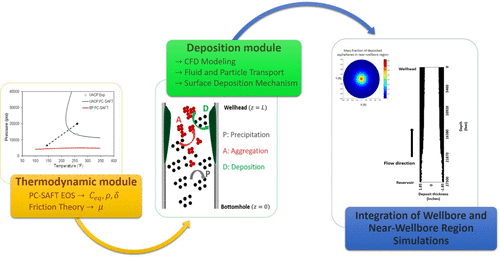当前位置:
X-MOL 学术
›
Energy Fuels
›
论文详情
Our official English website, www.x-mol.net, welcomes your
feedback! (Note: you will need to create a separate account there.)
Systematic Investigation of Asphaltene Deposition in the Wellbore and Near-Wellbore Region of a Deepwater Oil Reservoir under Gas Injection. Part 2: Computational Fluid Dynamics Modeling of Asphaltene Deposition
Energy & Fuels ( IF 5.2 ) Pub Date : 2018-12-04 00:00:00 , DOI: 10.1021/acs.energyfuels.8b03239 Narmadha Rajan Babu 1 , Pei-Hsuan Lin 1 , Mohammed I. L. Abutaqiya 1 , Caleb J. Sisco 1 , Jianxin Wang 2 , Francisco M. Vargas 1
Energy & Fuels ( IF 5.2 ) Pub Date : 2018-12-04 00:00:00 , DOI: 10.1021/acs.energyfuels.8b03239 Narmadha Rajan Babu 1 , Pei-Hsuan Lin 1 , Mohammed I. L. Abutaqiya 1 , Caleb J. Sisco 1 , Jianxin Wang 2 , Francisco M. Vargas 1
Affiliation

|
Asphaltene deposition during oil production is a major flow assurance problem. The asphaltene deposit layer reduces the pipe cross-section, leading to a significant reduction in the flow rate and eventually plugging the pipeline. This flow assurance problem caused during oil production has motivated the development of several experimental and modeling techniques to investigate the asphaltene behavior. This study proposes an integrated approach to simultaneously model asphaltene precipitation, aggregation, and deposition on a single platform. It focuses on the development of a deposition simulator that performs thermodynamic modeling using the perturbed chain version of the statistical associating fluid theory equation of state (PC-SAFT EOS) and depicts the deposition profile by means of a computational fluid dynamics (CFD) model based on the finite element method. In this work, the asphaltene deposition risk was assessed in the near-wellbore region and the production tubing as a result of gas breakthrough. To achieve this goal, a sample of crude C2 was analyzed to determine its properties and also the tendency of the asphaltenes contained in this sample to precipitate and deposit under various conditions. Laboratory-scale experiments were performed to analyze the rates of asphaltene precipitation, aggregation, and deposition. With the results obtained from the various experiments, advanced modeling methods based on PC-SAFT EOS and CFD models were calibrated and used to predict asphaltene precipitation and deposition under field conditions. Simulation methods for oil flow and asphaltene precipitation in the near-wellbore region of the reservoir and inside the production tubing were coupled to provide the most rigorous modeling approach ever developed to understand and predict this complex flow assurance problem. The results show a low to moderate asphaltene deposition rate produced by crude C2 as the gas breaks through. Nevertheless, further investigation is recommended to analyze the effect of other fluids that may be co-produced to enhance our ability to understand and predict asphaltene deposition under different conditions.
中文翻译:

注气下深水油藏井筒和近井筒区沥青质沉积的系统研究。第2部分:沥青沉积的计算流体动力学建模
采油过程中沥青质的沉积是主要的流量保证问题。沥青质沉积层减小了管道的横截面,导致流速显着降低,并最终堵塞了管道。在采油过程中引起的流动保证问题促使了一些实验和建模技术的发展,以研究沥青质的行为。这项研究提出了一种集成方法,可在单个平台上同时对沥青质的沉淀,聚集和沉积进行建模。它专注于沉积模拟器的开发,该模拟器使用统计关联流体理论状态方程(PC-SAFT EOS)的扰动链版本执行热力学建模,并通过基于计算流体动力学(CFD)模型的方式描述沉积轮廓在有限元方法上。在这项工作中,由于气体突破,评估了近井眼区域和生产油管中沥青质沉积的风险。为了实现该目标,分析了粗制C2的样品,以确定其性质以及该样品中所含沥青质在各种条件下沉淀和沉积的趋势。进行了实验室规模的实验,以分析沥青质的沉淀,聚集和沉积速率。从各种实验中获得的结果,校准了基于PC-SAFT EOS和CFD模型的高级建模方法,并用于预测野外条件下的沥青质沉淀和沉积。结合了油藏附近井眼区域和生产油管内部的油流和沥青质沉淀的模拟方法,以提供有史以来开发出的最严格的建模方法,以理解和预测这一复杂的流量保证问题。结果表明,当气体突破时,粗制C2会产生低至中等的沥青质沉积速率。但是,建议进一步研究以分析可能共同产生的其他流体的作用,以增强我们在不同条件下理解和预测沥青质沉积的能力。
更新日期:2018-12-04
中文翻译:

注气下深水油藏井筒和近井筒区沥青质沉积的系统研究。第2部分:沥青沉积的计算流体动力学建模
采油过程中沥青质的沉积是主要的流量保证问题。沥青质沉积层减小了管道的横截面,导致流速显着降低,并最终堵塞了管道。在采油过程中引起的流动保证问题促使了一些实验和建模技术的发展,以研究沥青质的行为。这项研究提出了一种集成方法,可在单个平台上同时对沥青质的沉淀,聚集和沉积进行建模。它专注于沉积模拟器的开发,该模拟器使用统计关联流体理论状态方程(PC-SAFT EOS)的扰动链版本执行热力学建模,并通过基于计算流体动力学(CFD)模型的方式描述沉积轮廓在有限元方法上。在这项工作中,由于气体突破,评估了近井眼区域和生产油管中沥青质沉积的风险。为了实现该目标,分析了粗制C2的样品,以确定其性质以及该样品中所含沥青质在各种条件下沉淀和沉积的趋势。进行了实验室规模的实验,以分析沥青质的沉淀,聚集和沉积速率。从各种实验中获得的结果,校准了基于PC-SAFT EOS和CFD模型的高级建模方法,并用于预测野外条件下的沥青质沉淀和沉积。结合了油藏附近井眼区域和生产油管内部的油流和沥青质沉淀的模拟方法,以提供有史以来开发出的最严格的建模方法,以理解和预测这一复杂的流量保证问题。结果表明,当气体突破时,粗制C2会产生低至中等的沥青质沉积速率。但是,建议进一步研究以分析可能共同产生的其他流体的作用,以增强我们在不同条件下理解和预测沥青质沉积的能力。





















































 京公网安备 11010802027423号
京公网安备 11010802027423号